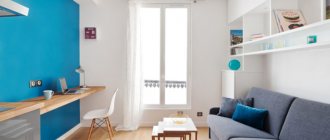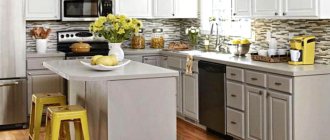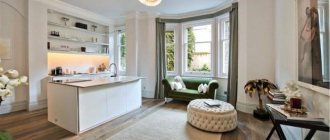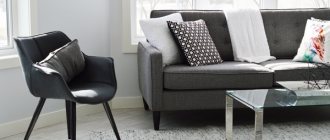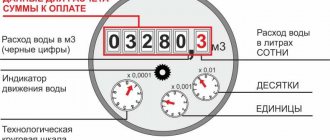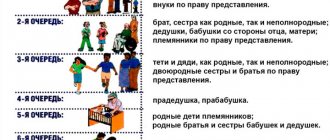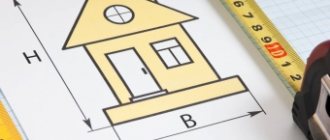Differences between living space and general space
Total area (TA) is the sum of square meters of all premises available in the apartment, regardless of their purpose, which are used to make payments for utility bills, in property purchase and sale agreements and for other purposes.
When conducting a transaction with a real estate property, as a rule, two terms appear in the documents - residential and total area. Even though it is easy to distinguish between them, some still make mistakes when using them.
It is important to know: The total square footage is the entire square footage of the apartment, which, according to documents, is classified as a given property, and the living space means only rooms suitable for habitation.
Below is the answer to the question what is the difference between the living area and the total area of an apartment:
- Dimensional parameters. The residential area represents only a part of the total, i.e. its size is smaller. Most often, this difference is significant; sometimes the footage for housing is equal to half of the total.
- Living space includes rooms (bedrooms, children's rooms, living rooms) where people spend most of their time at home. In addition to them, the OP includes all other square meters of housing.
- Purposes of use. The size of residential premises influences the living conditions of citizens (the possibility of receiving social benefits, adopting a child, etc.). The market value of housing, the amount of utility bills and contributions (for heating, major repairs) depend on the OP.
Below is information on how to calculate the area of an apartment by total footage.
What tricks do developers use to make money on space?
In order to give practical value to information about the types of area, let's talk about some of the tricks of developers. Of course, developers know how to juggle terms, projects, and changes. The closer to Moscow and St. Petersburg, the more schemes the developer knows. But the buyer should also be prepared for possible nuances.
Favorite “tricks” of developers:
- Free layout. An apartment without walls is not very good. You will still have to build them, and the area of the apartment will be greatly reduced.
Example. The apartment has an area of 60 sq.m. 3 walls will be erected, with a total length of 15 m and a width of 10 cm. As a result, the area of the structure will decrease by one and a half meters!
- "Apartments" instead of apartments. Previously, this type of real estate was used to circumvent the law on shared construction. Now the scheme has become less common, but has not lost its relevance.
- “Hiding” balconies and loggias. These premises may be reflected in the apartment plan as part of the living space, which will increase the cost of housing.
- Construction of common property of a larger area with its subsequent transfer to someone else’s use. Part 4 of Article 36 of the Housing Code of the Russian Federation allows this, but the construction of common real estate is paid for at the expense of shareholders. Why should anyone else use it?
What's included
The total square footage includes all the premises that make up a housing unit in an apartment building:
- Residential premises (rooms). These are bedrooms, living rooms, children's rooms, where people sleep, work, relax - spend their leisure time at home.
- Kitchens. Regardless of the amount of time residents spend in the kitchen, this room is still classified as a household room and is included in the total area. Even if the owner decided to arrange a place to relax there and spends all his free time there, this does not affect the purpose of the kitchen.
- Corridors that connect the rooms inside the apartment with each other.
- Rooms for sanitary purposes (bathrooms, toilets) do not belong to living space. They are part of the overall footage.
- Wall closets also belong to the OP, despite the fact that residents, as a rule, do not go into them at all.
- Niches in the walls of Stalin-style houses designed for storing food in winter, instead of a refrigerator.
What doesn't turn on
Some people mistakenly believe that when calculating the total area of an apartment, all premises of the property should be included, but in this case there are exceptions. The following square meters are not included in the accounting of the OP:
- Balconies, loggias. Until recently, they were taken into account with a reducing factor - 1/2 from the loggia and 1/3 from the balcony were included, but now they have been excluded from the calculation completely.
- Verandas, terraces. These places are intended for a person to relax and engage in his hobby (for example, growing flowers). Therefore, they are not taken into account when calculating the total footage.
- Niches with a height of less than 1.8 m. Thus, low wall cabinets are not included in the OP.
- The place under the stairs with a span height of less than 1.6 m from the floor (the distance must be measured with a tape measure at right angles to the floor). This applies to two-level apartments.
- Stoves and fireplaces. Even if they are in working order, the space under them is not included in the total area.
- Doors and arched structures less than 2 meters wide, i.e. they have a very low threshold. Therefore, it is not advisable to include them in the OP.
- Premises without heating, when the total square footage needs to be calculated in order to calculate the amount of payments for heating and check the calculations of the housing company.
Everything inside the walls is included in the area
Generally speaking, the area of your home is measured by the exterior walls. A cadastral engineer arriving at the site measures the house from the outside using satellite geodetic measurements. Essentially, the entire outline of the building from the outside is measured - and everything inside it will be taxed. So, for example, if you plan to build a house with half-meter thick partitions between the kitchen and living room, get ready for the fact that the area measured by the cadastral engineer will not match what you measure with a tape measure inside the building.
The area of your home on which property taxes will be calculated will include the total area of all floors, including:
- thickness of walls and partitions;
- area of staircase steps and interstairwells;
- area of storage rooms, loggias, verandas, terraces, bay windows, etc.;
- area of the ground floor, basement or attic;
- the area of the bathhouse and garage in the event that, apart from the house, they cannot perform their functions (for example, they have a common wall with the house).
The area of your home on which your property taxes will be calculated will include the total area of all floors.
Photo tochmash-ural.ru Cadastral engineer Liliya Kupchikhina warns:
— Often, when preparing documents, when the final area of the house is determined, people are surprised: why did it turn out to be so much? After all, they planned it completely differently. But the fact is that in the minds of many people there are still rules from those times when the area was still divided into residential and non-residential (for example, the corridor and bathroom were considered non-residential area, and the living room and children's room were considered residential). But now, according to the law, there is no such division. The area of your home is calculated in its entirety and is determined as the sum of the floor areas. And the floor area is calculated from the outer walls from the inside along the perimeter.
It turns out that no matter how thick the walls and partitions are from the inside, all this will not reduce the area of your home in any way. An interesting nuance: compared to the previously used calculation method, the area of the house is now becoming larger. This means that citizens pay more taxes on registered real estate.
Calculation rules
How to calculate the total area of an apartment is given below. This calculation is not difficult - you need to measure the area of all the rooms included in it and summarize the results. But there are some nuances that should be taken into account:
- To calculate the square footage of a rectangular room, you need to measure the lengths of its 2 walls, which are connected to each other. After this, the resulting numbers must be multiplied.
- A complex-shaped room can be mentally divided into rectangles, their areas can be calculated by analogy with the first option, and added. The result obtained will be equal to the area of the room.
- If the room has diagonal walls, then you should proceed in the same way: divide it into imaginary rectangles. That part, one of the sides of which is a wall at an angle to the other walls, will be a right triangle. Its area is equal to half the product of its legs (walls forming a right angle). Add all the obtained values together.
Recommendation: It is better to draw rectangular figures that are taken into account on paper using a ruler. This action will help reduce the likelihood of errors.
Room measurements must be taken from inside the room using a tape measure, applying it to the junction of the wall and the floor. It is better to perform these steps together for convenience.
Legislative basis
All issues that relate to residential premises in apartment buildings are regulated by the Housing Code of the Russian Federation.
Also, if the need arises, you can refer to such regulatory documents as:
- Construction norms and rules (SNiP) from 2003.
- Federal Law No. 384 of December 30, 2009, which presents technical regulations for the safety of buildings and structures.
Important: The priority of regulation among these documents belongs to the latter (Federal Law No. 384). Thus, its provisions may cancel the effect of some clauses of the RF Housing Code and SNiP 2003.
When studying the Housing Code in order to calculate the square footage of an apartment, it is especially necessary to highlight Article 15, which provides a definition of what exactly is the object of housing rights.
Types of residential premises (Article 16 of the Housing Code of the Russian Federation, Article 673 of the Civil Code of the Russian Federation)
- Residential building or part of a residential building*.
- Apartment or part of an apartment.
- Living room**.
* This refers to a single-apartment residential building (see paragraph 2 of Article 673 of the Civil Code of the Russian Federation, as well as Chapter 6 of the Housing Code of the Russian Federation).
** Part of the room cannot be considered as an independent object of housing relations.
In accordance with Article 15 of the RF Housing Code, the total area of residential premises includes “the area of auxiliary premises intended to satisfy citizens’ household and other needs related to their residence in residential premises,” but does not include “balconies, loggias, verandas and terraces.”
Living room is a part of a residential building or apartment intended for use as a place of direct residence of citizens in a residential building or apartment (Article 15, paragraph 4 of the Housing Code of the Russian Federation).
Living area is the sum of the areas of all living rooms.
It is necessary to distinguish between a living room as a separate type of living space (i.e., can a citizen be registered there) and a living room as part of the living area of an apartment or house (which is taken into account when determining the living area).
What does OP influence?
Some important points depend on the size of the apartment’s OP:
- The cost of the property for the buyer. An inexperienced person, when looking for housing, may mistakenly focus on the value of the OP. When choosing an option suitable for purchase, you should first of all concentrate on the size of the living space.
- Amount of heating payments. Utilities calculate based on total footage.
- The amount of contribution for major home repairs. The amount of payment for general building repairs directly depends on the square footage of the entire apartment of each specific owner.
- Comfort of living. The size of the living space has a direct impact on the comfortable living conditions of each person. But the OP is no less important, since it also includes other rooms that play an important role for the convenience of living (bathrooms, storage rooms, cabinets in niches, kitchen).
OP is an important parameter for the apartment owner. Many aspects depend on it: from the market price to the comfort of living. The general quadrature should be distinguished from the residential quadrature, which includes only living rooms. The main legislative document regulating issues related to the square footage of citizens' housing is the Housing Code of the Russian Federation. It also provides an answer to a fairly popular question among citizens, whether the loggia is included in the total area of the apartment. The regulatory document clearly states which premises are included in the OP and which are not. This parameter is calculated by calculating the square footage of each room of the property.
How to calculate area?
Since the owner himself can calculate the area of the apartment, there is no need to spend extra money on the services of private companies.
The area is calculated as follows:
- total area – living rooms + utility rooms + balconies, loggias;
- living space - bedrooms, guest rooms + kitchen, corridor, loggia (if redevelopment has been carried out and the apartment has been made into a studio).
Important! When making calculations, it is necessary to take into account the reduction factor: balconies, terraces - 0.3%, loggias - 0.5%, verandas and cold storage rooms - 1%.

